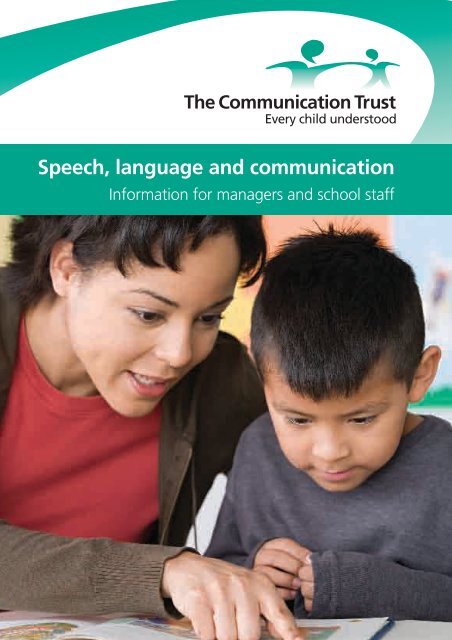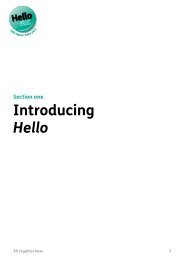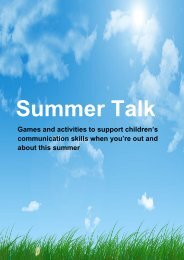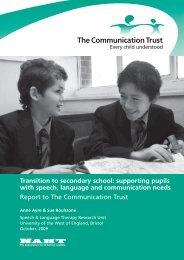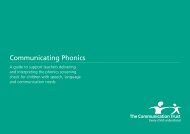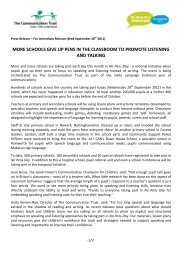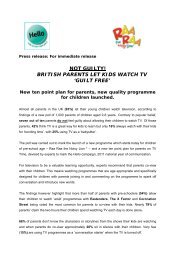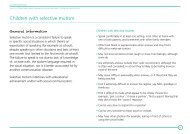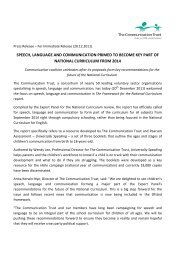Speech, language and communication - The Communication Trust
Speech, language and communication - The Communication Trust
Speech, language and communication - The Communication Trust
Create successful ePaper yourself
Turn your PDF publications into a flip-book with our unique Google optimized e-Paper software.
<strong>Speech</strong>, <strong>language</strong> <strong>and</strong> <strong>communication</strong><br />
Information for managers <strong>and</strong> school staff
Introduction<br />
<strong>The</strong> <strong>Communication</strong> <strong>Trust</strong> has developed<br />
this short guide to help schools support<br />
children’s speech, <strong>language</strong> <strong>and</strong><br />
<strong>communication</strong>. It outlines some key<br />
information on speech, <strong>language</strong> <strong>and</strong><br />
<strong>communication</strong> useful for all teaching<br />
staff but of particular interest to SENCOs,<br />
literacy co-ordinators <strong>and</strong> those working<br />
with children who have speech, <strong>language</strong><br />
<strong>and</strong> <strong>communication</strong> needs (SLCN).<br />
This booklet provides information on<br />
resources developed to help school<br />
staff support speech, <strong>language</strong> <strong>and</strong><br />
<strong>communication</strong> including a free resource<br />
supported by <strong>The</strong> <strong>Communication</strong> <strong>Trust</strong><br />
<strong>and</strong> developed by I CAN <strong>and</strong> the BT Better<br />
World Campaign. This booklet also provides<br />
information on a range of organisations<br />
providing support in this area <strong>and</strong> signposts<br />
further support via<br />
www.<strong>communication</strong>helppoint.org.uk<br />
<strong>Speech</strong>, <strong>language</strong> <strong>and</strong> <strong>communication</strong> in<br />
primary schools<br />
We expect that when children start primary<br />
school, they do so with proficient speech,<br />
<strong>language</strong> <strong>and</strong> <strong>communication</strong> skills; we expect<br />
they will be able to underst<strong>and</strong> much of what<br />
is said, express themselves clearly, share their<br />
feelings <strong>and</strong> make their needs known. Language<br />
is the vehicle for most learning <strong>and</strong> we know<br />
this proficiency in speech, <strong>language</strong> <strong>and</strong><br />
<strong>communication</strong> is critical to the development<br />
of children’s cognitive, social <strong>and</strong> emotional<br />
well-being. 1 2<br />
All children can benefit from support in speech<br />
<strong>language</strong> <strong>and</strong> <strong>communication</strong>. We know<br />
how important <strong>language</strong> is for learning <strong>and</strong><br />
attainment.<br />
<strong>The</strong>re are links between speech, <strong>language</strong> <strong>and</strong><br />
<strong>communication</strong> with learning, behaviour, social<br />
skills <strong>and</strong> self-esteem. Good underst<strong>and</strong>ing<br />
<strong>and</strong> use of <strong>language</strong> is needed to support the<br />
success of programmes such as social emotional<br />
aspects of learning (SEAL ) . 3 <strong>Speech</strong>, <strong>language</strong><br />
<strong>and</strong> <strong>communication</strong> skills are essential in<br />
the development of skills for life <strong>and</strong><br />
work.<br />
But it is important to define what we<br />
mean when we talk about speech,<br />
<strong>language</strong> <strong>and</strong> <strong>communication</strong>.
What do we mean by speech,<br />
<strong>language</strong> <strong>and</strong> <strong>communication</strong>?<br />
By speech we mean<br />
l <strong>The</strong> speech sounds children use to build up<br />
words, saying sounds accurately <strong>and</strong> in the<br />
right places<br />
l Speaking fluently, without hesitating,<br />
prolonging or repeating words or sounds<br />
l Speaking with expression <strong>and</strong> a clear voice,<br />
using pitch, volume <strong>and</strong> intonation to<br />
support meaning<br />
By <strong>language</strong> we mean both talking<br />
(expressive <strong>language</strong>) <strong>and</strong> underst<strong>and</strong>ing<br />
of <strong>language</strong><br />
By expressive <strong>language</strong> we mean;<br />
l Having words to describe objects, actions<br />
<strong>and</strong> attributes<br />
l Using these words to build up sentences<br />
l Using these sentences to build up<br />
conversations <strong>and</strong> narratives<br />
l Following the rules of grammar, so that<br />
things make sense<br />
By <strong>communication</strong> we mean the way in<br />
which <strong>language</strong> is used to interact with<br />
others<br />
l Using <strong>language</strong> in different ways; to<br />
question, clarify, describe <strong>and</strong> debate<br />
l Using non-verbal rules of <strong>communication</strong>:<br />
listening, looking, knowing how to take<br />
verbal turns <strong>and</strong> how to change <strong>language</strong><br />
use to suit the situation<br />
l <strong>The</strong> ability to take into account other<br />
people’s perspectives, intentions <strong>and</strong> wider<br />
context<br />
We need all three elements in order to get our<br />
messages across. Each of the three elements is<br />
multifaceted <strong>and</strong> multilayered. Without aspects<br />
of any one of these elements, what children say<br />
<strong>and</strong> underst<strong>and</strong> can become confused. With<br />
all these elements, children can maximise their<br />
attainment.<br />
By underst<strong>and</strong>ing we mean;<br />
l Processing <strong>and</strong> making sense of what<br />
people say<br />
l Underst<strong>and</strong>ing words being spoken<br />
l Underst<strong>and</strong>ing the rules of grammar used
<strong>The</strong> importance of speech,<br />
<strong>language</strong> <strong>and</strong> <strong>communication</strong><br />
Many teachers are aware of the importance<br />
of speech, <strong>language</strong> <strong>and</strong> <strong>communication</strong>,<br />
though they may also feel they do not<br />
have the skills needed to support pupils<br />
with difficulties. Teachers have reported<br />
a lack of confidence both in assessing the<br />
spoken <strong>language</strong> of their pupils <strong>and</strong> in<br />
implementing strategies to support the<br />
development of <strong>communication</strong> skills,<br />
particularly when children have difficulties. 4<br />
It is vital that all primary school staff, from the<br />
head teacher to lunchtime supervisors, have the<br />
skills <strong>and</strong> knowledge to support <strong>communication</strong><br />
in the classroom <strong>and</strong> the school community as<br />
a whole.<br />
Professional development is key <strong>and</strong> has been<br />
identified as critically important in achieving<br />
positive outcomes for all children.<br />
Why we all need to think about speech,<br />
<strong>language</strong> <strong>and</strong> <strong>communication</strong><br />
Language is fundamental to all learning <strong>and</strong><br />
crucial for development in primary school<br />
children; 5 poor <strong>language</strong> skills will impact on<br />
children’s attainment in school.<br />
<strong>The</strong>se can be divided into two groups; the first<br />
group, around 5-7% of all children, has speech,<br />
<strong>language</strong>, <strong>communication</strong> needs (SLCN) 7<br />
arising from a primary <strong>and</strong> specific <strong>language</strong><br />
impairment, that is <strong>language</strong> impairment in the<br />
absence of any other learning difficulty.<br />
<strong>The</strong> second group has SLCN as part of another<br />
underlying learning need, such as autistic<br />
spectrum disorder or learning difficulties.<br />
SLCN is identified by DCSF in the pupil level<br />
annual school census (PLASC) 8 data as one<br />
of the SEN subtypes. <strong>The</strong> <strong>Communication</strong><br />
<strong>Trust</strong> uses the term SLCN as an umbrella term<br />
to include all children who are experiencing<br />
difficulty with any aspect of speech, <strong>language</strong><br />
<strong>and</strong> <strong>communication</strong>, those with long term<br />
more persistent needs <strong>and</strong> those with delayed<br />
<strong>language</strong>.<br />
We all need to concentrate on speech, <strong>language</strong><br />
<strong>and</strong> <strong>communication</strong> because of the massive<br />
impact these skills have on children’s overall<br />
development. All children, including the most<br />
able, will benefit from support with speech,<br />
<strong>language</strong> <strong>and</strong> <strong>communication</strong>.<br />
We know that many teachers recognise how<br />
important <strong>language</strong> <strong>and</strong> <strong>communication</strong> is for<br />
children’s progress. Teachers have also expressed<br />
concern that many children are starting school<br />
with inadequate <strong>language</strong> skills. 6<br />
In addition to the children coming into school<br />
with ‘delayed <strong>language</strong>’, there is a group<br />
of children with more persistent long term<br />
difficulties.
What happens when<br />
<strong>language</strong> doesn’t develop?<br />
<strong>The</strong>re is a substantial amount of evidence<br />
linking SLCN with other areas of difficulty.<br />
We know that children with SLCN have<br />
difficulties across many areas of their lives.<br />
Children with SLCN have more difficulty with<br />
many aspects of learning compared to their<br />
peers. <strong>The</strong>y can have difficulties with developing<br />
all aspects of literacy skills, (reading, writing<br />
<strong>and</strong> spelling), causing difficulties in accessing all<br />
areas of the curriculum.<br />
Listening <strong>and</strong> underst<strong>and</strong>ing teachers’<br />
instructions is challenging for those children<br />
with difficulties underst<strong>and</strong>ing <strong>language</strong>. For<br />
example, they may know <strong>and</strong> underst<strong>and</strong> how<br />
to build a rocket, but not underst<strong>and</strong> the verbal<br />
instructions that tell them what to do.<br />
Many children with SLCN have poor<br />
underst<strong>and</strong>ing <strong>and</strong> use of vocabulary, meaning<br />
every aspect of the curriculum can be confusing<br />
<strong>and</strong> their ability to learn the vocabulary can be<br />
significantly impaired.<br />
<strong>The</strong>y often have difficulties with skills such as<br />
reasoning <strong>and</strong> predicting, so although they<br />
could demonstrate what will happen next in<br />
a science experiment, their <strong>language</strong> does not<br />
allow them to verbalise it. Sometimes they just<br />
need more time to process <strong>language</strong> – it may be<br />
that while they are listening <strong>and</strong> processing one<br />
instruction, the next piece of information has<br />
already been said.<br />
<strong>The</strong> pace <strong>and</strong> level of <strong>language</strong> used to teach<br />
the curriculum therefore acts as a barrier to<br />
learning, rather than a facilitator.<br />
Children’s frustrations can bubble to the surface<br />
when trying to learn in an environment where<br />
their weakness is also the vehicle for learning.<br />
As a result, many children with SLCN can<br />
demonstrate behaviour difficulties ranging from<br />
occasional bouts of unpredictable behaviour to<br />
specific patterns of misbehaviour. Conversely,<br />
we also know that many children with identified<br />
behavioural, emotional, social difficulties (BESD)<br />
have unidentified <strong>language</strong> difficulties.<br />
Without good <strong>communication</strong> skills, the ability<br />
to form <strong>and</strong> maintain friendships can be<br />
affected. Some children become withdrawn,<br />
whereas others display behaviour difficulties.<br />
As they move towards the end of their primary<br />
years, children with long term SLCN become<br />
much more aware of their areas of difficulty<br />
<strong>and</strong> research has shown they view themselves<br />
in a more negative light, both educationally <strong>and</strong><br />
socially, than their peers. 9<br />
Language is an all day every day activity, it<br />
pervades the primary school curriculum <strong>and</strong><br />
community <strong>and</strong> has a massive impact on<br />
children’s learning <strong>and</strong> school experience. As<br />
such, it is something that needs to be considered<br />
<strong>and</strong> planned for across the curriculum.<br />
We all need to know what to expect from<br />
children at different ages. <strong>The</strong>se are the<br />
foundation skills for learning <strong>and</strong> socialising.<br />
Without them, success in other areas is seriously<br />
at risk.
Resources to support the<br />
children’s workforce<br />
<strong>The</strong> <strong>Speech</strong>, Language <strong>and</strong> <strong>Communication</strong><br />
Framework (SLCF)<br />
<strong>The</strong> SLCF has been developed by <strong>The</strong><br />
<strong>Communication</strong> <strong>Trust</strong> to help all people working<br />
with children to consider their professional<br />
development in relation to children’s speech,<br />
<strong>language</strong> <strong>and</strong> <strong>communication</strong>. It maps to<br />
teachers professional st<strong>and</strong>ards <strong>and</strong> supports<br />
development for wider school staff groups.<br />
It provides competences at four different<br />
stages, from Universal, supporting awareness<br />
of <strong>communication</strong> for the entire children’s<br />
workforce (in schools this would mean teachers,<br />
teaching assistants, midday meal supervisors<br />
etc.), to Extension, for highly specialised<br />
practitioners. All staff can work through the<br />
Framework <strong>and</strong> identify their strengths <strong>and</strong> areas<br />
for development.<br />
<strong>The</strong> SLCF can be used by individuals to evaluate<br />
their knowledge <strong>and</strong> skills, or as a whole school<br />
staff group to identify where the skills lie <strong>and</strong><br />
support planning for whole school development.<br />
<strong>The</strong> SLCF aims to improve outcomes for all<br />
children by being clear about what skills<br />
<strong>and</strong> knowledge staff need to support good<br />
<strong>communication</strong> skills.<br />
It highlights strengths <strong>and</strong> identifies areas<br />
for development. It also helps staff to find<br />
relevant training courses <strong>and</strong> consider other<br />
practical or collaborative ways to develop<br />
skills <strong>and</strong> knowledge in those areas identified<br />
for development. As a competence based<br />
framework, that is related to the Integrated<br />
Qualifications Framework (IQF), it could be used<br />
to support staff at different levels in their work<br />
towards achieving recognised qualifications<br />
eg. NVQs.<br />
<strong>The</strong> SLCF also provides guidance on what training<br />
courses are available <strong>and</strong> would meet the needs<br />
of individuals or school settings. It is a tool for<br />
staff to think about supporting <strong>communication</strong> in<br />
all children, including those with particular needs.<br />
Please visit www.<strong>communication</strong>helppoint.org.uk<br />
<strong>The</strong> <strong>Communication</strong> Cookbook<br />
This is a new free resource produced by the BT<br />
Better World Campaign, developed by I CAN <strong>and</strong><br />
distributed by <strong>The</strong> <strong>Communication</strong> <strong>Trust</strong>. It is a<br />
free resource targeted at parents <strong>and</strong> teachers of<br />
children in reception <strong>and</strong> year 1, though it can be<br />
used <strong>and</strong> easily adapted for other age groups.<br />
It consists of:<br />
l <br />
l <br />
l <br />
l <br />
A book, full of information <strong>and</strong> activities to<br />
encourage <strong>language</strong> <strong>and</strong> <strong>communication</strong><br />
skills in children<br />
A DVD demonstrating some of the activities,<br />
including feedback from the schools who<br />
tested the book <strong>and</strong> more information about<br />
speech, <strong>language</strong> <strong>and</strong> <strong>communication</strong><br />
Online interactive games for children to<br />
support their <strong>language</strong> skills<br />
A library of 160 picture cards to download<br />
<strong>and</strong> use in the games<br />
To help teachers <strong>and</strong> parents involve speech,<br />
<strong>language</strong> <strong>and</strong> <strong>communication</strong> in their day to day<br />
lives, <strong>The</strong> <strong>Communication</strong> Cookbook contains<br />
lots of activities concerning different areas of<br />
speaking <strong>and</strong> listening.
What happens when <strong>language</strong> doesn’t develop?<br />
Resources to support the<br />
children’s workforce<br />
<strong>The</strong> <strong>Communication</strong> Cookbook contains 20<br />
activities across the following core str<strong>and</strong>s of<br />
<strong>language</strong>:<br />
l<br />
l<br />
l<br />
l<br />
l<br />
Attention <strong>and</strong> listening skills<br />
Vocabulary<br />
Building sentences<br />
Telling stories<br />
Conversations<br />
We know how busy teachers <strong>and</strong> parents are,<br />
so we have tried to make the activities easy to<br />
underst<strong>and</strong> <strong>and</strong> quick to use without too much<br />
preparation. <strong>The</strong> picture library helps with this<br />
<strong>and</strong> can also be printed to create a really useful<br />
resource which could be used in many different<br />
ways. We have used vocabulary from Ann Locke’s<br />
Living Language programme, 10 a well-regarded<br />
programme for supporting vocabulary <strong>and</strong><br />
<strong>language</strong> development, to ensure words are<br />
relevant to the age of children involved.<br />
Simple <strong>language</strong> is used throughout <strong>and</strong> is<br />
predominantly presented in the present tense to<br />
support ‘here <strong>and</strong> now’ underst<strong>and</strong>ing. We have<br />
also given simple information on each activity<br />
which helps parents, teachers <strong>and</strong> children<br />
themselves to underst<strong>and</strong> what they are learning<br />
whilst playing the games.<br />
<strong>The</strong> games support different elements of<br />
effective speaking <strong>and</strong> listening which are<br />
needed for development of <strong>language</strong> <strong>and</strong><br />
<strong>communication</strong>. Setting the games <strong>and</strong><br />
activities within an environment that supports<br />
<strong>communication</strong> enhances them even further.<br />
To support this idea there is an additional set of<br />
activities to help teachers <strong>and</strong> parents create an<br />
environment which supports <strong>communication</strong>.<br />
Sometimes just being more aware of <strong>language</strong><br />
<strong>and</strong> <strong>communication</strong> can help staff to make the<br />
small changes that have the biggest impact on<br />
children’s speaking <strong>and</strong> listening.<br />
<strong>The</strong> <strong>Communication</strong> Cookbook is a simple yet<br />
effective resource. It has been trialled with<br />
teachers <strong>and</strong> parents who have been positive<br />
about how easy it is to use <strong>and</strong> the changes<br />
they’ve seen in children. Here are some of<br />
their comments…<br />
’<strong>The</strong> staff were<br />
really pleased to have<br />
something concrete to<br />
help them get going with<br />
speaking <strong>and</strong> listening.’<br />
SENCO<br />
‘You wouldn’t<br />
believe the change in<br />
the children in one day..<br />
it was ‘eye popping.’<br />
Reception class<br />
teacher<br />
‘It’s good to<br />
make it all explicit –<br />
we do it, but we don’t<br />
make it explicit.’<br />
Teacher<br />
Order your free copy now for July delivery<br />
from www.ican.org.uk/cookbook
Resources to support the<br />
children’s workforce<br />
AFASIC<br />
Afasic is the UK charity representing the<br />
needs of children <strong>and</strong> young people with<br />
speech <strong>and</strong> <strong>language</strong> impairments, providing<br />
help, information <strong>and</strong> support to parents <strong>and</strong><br />
professionals working with this vulnerable group.<br />
Afasic has a range of resources <strong>and</strong> materials<br />
for parents <strong>and</strong> professionals, which includes<br />
information about different types of impairments,<br />
speech <strong>and</strong> <strong>language</strong> therapy, educational<br />
provision, <strong>and</strong> strategies to support children <strong>and</strong><br />
young people. Please visit the Afasic website<br />
www.afasic.org.uk or if you have an immediate<br />
concern please ring the Afasic Helpline on<br />
08453 55 55 77.<br />
<strong>The</strong> BT Better World Campaign<br />
BT Better World provides an extensive range<br />
of free resources to help teachers, parents<br />
<strong>and</strong> children improve their <strong>communication</strong><br />
skills, with a particular focus on dialogue. In<br />
addition, BT offers in-school support from BT<br />
volunteers, drama teams <strong>and</strong> trainers. All the<br />
resources are based on the TalkWorks model of<br />
<strong>communication</strong>. See www.btbetterworld.com<br />
to download <strong>and</strong> order free resources.<br />
<strong>The</strong> <strong>Communication</strong> <strong>Trust</strong><br />
<strong>The</strong> <strong>Communication</strong> <strong>Trust</strong> links to the SLCF <strong>and</strong><br />
contains a range of resources including links to<br />
over 20 different voluntary organisations in this<br />
field. www.the<strong>communication</strong>trust.org.uk<br />
I CAN<br />
I CAN is the children’s <strong>communication</strong> charity. It<br />
offers a whole range of resources with the aim of<br />
raising awareness of the importance of speech,<br />
<strong>language</strong> <strong>and</strong> <strong>communication</strong> <strong>and</strong> supporting<br />
schools <strong>and</strong> parents to identify <strong>and</strong> support those<br />
children with SLCN.<br />
Talking Point<br />
Talking Point is the first stop online for<br />
information on <strong>communication</strong> in children,<br />
including some great tips for supporting<br />
children’s <strong>communication</strong> in the classroom <strong>and</strong><br />
essential information for parents. Visit<br />
www.talkingpoint.org.uk<br />
Targeting Talk<br />
Was developed between I CAN <strong>and</strong> Serco giving<br />
detailed level descriptors linked to P Scales <strong>and</strong><br />
the National Curriculum, from P4 to Level 5,<br />
focused on pupils’ expressive, receptive <strong>and</strong> social<br />
use of <strong>language</strong>.<br />
It has a reference bank of successful classroom<br />
strategies to promote speaking <strong>and</strong> listening<br />
skills. Its aim is to support teachers to be able to<br />
identify levels of children’s functioning in speech,<br />
<strong>language</strong> <strong>and</strong> <strong>communication</strong>.<br />
Primary Talk<br />
Primary Talk is being developed by I CAN in<br />
partnership with Somerset Total <strong>Communication</strong><br />
(STC) <strong>and</strong> Somerset Local Authority. It follows<br />
on from the successful Early Talk programme,<br />
though focussed on the primary phase of<br />
education. It is a systematic approach to<br />
developing all children’s <strong>communication</strong> skills<br />
through training <strong>and</strong> service development.<br />
I CAN Talk Series<br />
I CAN Talk is a series of papers exploring<br />
contemporary issues in children’s <strong>communication</strong>
Resources to support the<br />
children’s workforce<br />
development. I CAN Talk papers review current<br />
research <strong>and</strong> literature <strong>and</strong> offer practical<br />
evidence-based solutions to inform debate <strong>and</strong> to<br />
support practitioners, parents <strong>and</strong> policy makers.<br />
<strong>The</strong> latest issue is called <strong>Speech</strong>, Language<br />
<strong>and</strong> <strong>Communication</strong> Needs <strong>and</strong> Primary-aged<br />
Children.<br />
I CAN schools<br />
I CAN has two day <strong>and</strong> residential schools which<br />
provide intensive support for pupils with severe<br />
<strong>and</strong> complex <strong>communication</strong> needs aged 4-19.<br />
Meath School, Surrey (for ages 4-11)<br />
01932 872302 or meath@meath-ican.org.uk<br />
Dawn House School, Nottinghamshire (all ages)<br />
01623 795361 dawnhouse@ican.org.uk<br />
<strong>Communication</strong> Skills Centres (CSC)<br />
Meath School <strong>and</strong> Dawn House School<br />
operate <strong>Communication</strong> Skills Centres which<br />
provide independent assessment of children’s<br />
<strong>communication</strong> skills <strong>and</strong> their impact on learning.<br />
Outreach <strong>and</strong> consultancy services are also<br />
offered from the CSCs; these include audit,<br />
advice, guidance <strong>and</strong> training for individual<br />
pupils, schools, statutory, voluntary <strong>and</strong><br />
commercial sectors.<br />
For more information on I CAN go to<br />
www.ican.org.uk<br />
National Strategies<br />
Inclusion Development Programme (IDP):<br />
Dyslexia <strong>and</strong> <strong>Speech</strong>, Language <strong>and</strong><br />
<strong>Communication</strong> Needs<br />
Offered through the National Strategies, this is<br />
an interactive DCSF-funded training resource<br />
which takes the form of a DVD <strong>and</strong> web-based<br />
materials. <strong>The</strong> resource has been designed to<br />
serve two purposes:<br />
- to support headteachers, SENCOs <strong>and</strong><br />
leadership teams in planning to raise the<br />
attainment of children with dyslexia or SLCN<br />
- to support teachers <strong>and</strong> support staff in<br />
planning for inclusion <strong>and</strong> in the further<br />
development of teaching strategies to effectively<br />
meet the needs of pupils with dyslexia or SLCN.<br />
<strong>The</strong> resource is not intended to provide highlevel<br />
specialist training. Rather, it is designed to<br />
increase the confidence of teachers <strong>and</strong> others<br />
when identifying <strong>and</strong> addressing SEN. Although<br />
focusing specifically on <strong>Communication</strong> Needs<br />
<strong>and</strong> Dyslexia, the material presented represents<br />
good quality first teaching (QFT) <strong>and</strong> is therefore<br />
more generally applicable.<br />
It is targeted at both primary <strong>and</strong> secondary<br />
schools, in order to support continuity <strong>and</strong><br />
progression, with elements specific to primary or<br />
secondary <strong>and</strong> some elements that are for both.<br />
<strong>The</strong> DVD includes video exemplification drawn<br />
from primary <strong>and</strong> secondary schools, a glossary<br />
of terms <strong>and</strong> a library of resources, as well as<br />
with links to useful websites which provide access<br />
to routes to further professional development,<br />
training <strong>and</strong> resources. <strong>The</strong> resource can be<br />
accessed through the National Strategies website<br />
at www.st<strong>and</strong>ard.dfes.gov.uk/primary/<br />
features/inclusion/sen/idp
Two conversation games<br />
From <strong>The</strong> <strong>Communication</strong> Cookbook<br />
<strong>The</strong>se games provide children with the<br />
opportunity to practise their conversation<br />
skills.<br />
<strong>The</strong> games are great to play with a single child<br />
whenever you have a few minutes to spare;<br />
for example, when you’re driving, waiting in a<br />
queue, having a meal, <strong>and</strong> so on.<br />
If you play as a group, sit the children in a<br />
circle, if possible on chairs (this seems to work<br />
better). About eight is the ideal number. Remind<br />
the children how important it is to take turns<br />
<strong>and</strong> do ‘good listening’. Once the children are<br />
familiar with the game, let them each have a go<br />
at being the group leader.<br />
It’s important for you to join in <strong>and</strong> play an<br />
active role. And don’t forget to praise helpful<br />
behaviour. ‘That was lovely listening, Kim. You<br />
knew exactly what Darren said.’<br />
1. Introductions<br />
Say your name very clearly <strong>and</strong> then add a detail<br />
about yourself that begins with the same sound<br />
as your name. For example: ‘My name is Jane<br />
<strong>and</strong> I like jogging.’ <strong>The</strong> children take turns at<br />
making their own statements. ‘My name is<br />
Ramesh <strong>and</strong> I like rhubarb.’ ‘My name is Alana<br />
<strong>and</strong> I like apples.’<br />
You can change the style of the introduction.<br />
For example: ‘My name is Mathew <strong>and</strong> I don’t<br />
like mice.’ ‘My name is Christopher <strong>and</strong> I don’t<br />
like carrots.’<br />
Another variation might be: ‘My name is<br />
Sally <strong>and</strong> I am sweet.’ ‘My name is Carlos <strong>and</strong><br />
I am quick.’<br />
2. Presents for all<br />
Children take turns at saying what they would<br />
give each other for a birthday or Christmas<br />
present – <strong>and</strong> (very importantly) why. Example:<br />
‘I’d get Jane a Dr Who money box because Dr<br />
Who is her favourite TV show.’<br />
Order your free copy now for July delivery<br />
from www.ican.org.uk/cookbook
<strong>The</strong> purpose of <strong>The</strong> <strong>Communication</strong> <strong>Trust</strong> is<br />
to raise awareness of the importance of speech,<br />
<strong>language</strong> <strong>and</strong> <strong>communication</strong> across the<br />
children’s workforce <strong>and</strong> to enable practitioners<br />
to access the best training <strong>and</strong> expertise to<br />
support the <strong>communication</strong> needs of<br />
all children.<br />
<strong>The</strong> <strong>Trust</strong> was founded by Afasic, BT Better<br />
World Campaign, Council for Disabled Children<br />
<strong>and</strong> I CAN. <strong>The</strong> <strong>Trust</strong> is supported by over 20<br />
voluntary <strong>and</strong> community groups who deliver<br />
services <strong>and</strong> support to children with SLCN.<br />
<strong>The</strong> <strong>Communication</strong> <strong>Trust</strong> is also working<br />
closely with a number of lead bodies in the<br />
field of workforce development including the<br />
Children’s Workforce Development Council<br />
(CWDC) <strong>and</strong> the Training <strong>and</strong> Development<br />
Agency for Schools (TDA) <strong>and</strong> with professional<br />
groups in the field of speech, <strong>language</strong> <strong>and</strong><br />
<strong>communication</strong> including Royal College of<br />
<strong>Speech</strong> <strong>and</strong> Language <strong>The</strong>rapists (RCSLT) <strong>and</strong><br />
National Association of Professionals concerned<br />
with Language Impairment in Children (NAPLIC).<br />
<strong>The</strong> <strong>Trust</strong>’s work is being supported by the<br />
Department for Children, Schools <strong>and</strong> Families<br />
<strong>and</strong> other funders. <strong>The</strong> <strong>Trust</strong> is hosted by I CAN<br />
<strong>and</strong> works to a representative board.<br />
www.the<strong>communication</strong>trust.org.uk<br />
1. Rose, J. (2006) Independent Review of the Teaching of Early Reading<br />
DfES<br />
2. Dr Tanya Byron, Chatter Matters DVD, www.ican.org.uk<br />
3. Social <strong>and</strong> emotional aspects of learning... improving behaviour...<br />
improving learning. DfES Aug 2007. www.st<strong>and</strong>ards.dfes.gov.uk/<br />
primary/publicaions/b<strong>and</strong>a/seal<br />
4. I CAN YouGov survey (2007)<br />
5. Goswami, U. <strong>and</strong> Bryant, P. (2007) Children’s Cognitive Development<br />
<strong>and</strong> Learning (Primary Review Research Survey 2/1a), Cambridge:<br />
University of Cambridge Faculty of Education.<br />
6. Basic Skills Agency (2002) Summary Report into Young Children’s<br />
Skills on Entry to Education<br />
7. Lindsay, G. <strong>and</strong> Dockrell, J. with Mackie, C. <strong>and</strong> Becky Letchford<br />
(2002) Educational Provision for Children with Specific <strong>Speech</strong> <strong>and</strong><br />
Language Difficulties in Eng<strong>and</strong> <strong>and</strong> Wales CEDAR<br />
8. DCSF 2007 National Statistics first release, Sept 2007<br />
9. Jerome, A.C., Fujiki, M., Brinton, B. <strong>and</strong> James, S. (2002) Self-esteem<br />
in Children with Specific Language Impairment Journal of <strong>Speech</strong>,<br />
Language <strong>and</strong> Hearing Research 45,4<br />
10. Locke, A. (1995) Living Language, NFER Nelson
To find out more:<br />
Cara Evans<br />
Programme Manager<br />
<strong>The</strong> <strong>Communication</strong> <strong>Trust</strong><br />
020 7843 2553<br />
cevans@the<strong>communication</strong>trust.co.uk<br />
Anita Kerwin-Nye<br />
Director<br />
<strong>The</strong> <strong>Communication</strong> <strong>Trust</strong><br />
8 Wakley Street<br />
London<br />
EC1V 7QE<br />
www.the<strong>communication</strong>trust.co.uk<br />
<strong>The</strong> <strong>Trust</strong> has a stakeholder group of expert organisations across the voluntary <strong>and</strong> community sector. If your<br />
organisation has expertise in the area of children <strong>and</strong> young people’s speech, <strong>language</strong> <strong>and</strong> <strong>communication</strong> <strong>and</strong><br />
you are interested in joining the stakeholder group, please contact Anita Kerwin-Nye or Cara Evans for further<br />
information.


